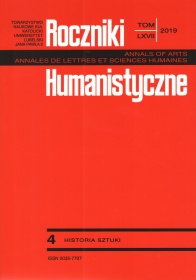Occasional decoration (1715) in the Jesuit church in Lublin. Iconography of St. Stanislaus Kostka
Abstract
Lublin, a city that is the seat of the Crown Tribunal, was one of the centers where St. Stanislaus Kostka was especially venerated. The main center of worship was the former Jesuit church of the St. John the Baptist and St. John the Evangelist (the present cathedral), where the miraculous image of the young man was kept.
The discovery of the note in the hand-written chronicle of the Romanum Societatis Jesu Archives reminds us of the occasional decoration of the Jesuit church during ceremonies connected with the announcement of the canonization of Stanislaus Kostka in 1715. The expanded multifaceted picture-verbal decoration focused primarily on the facade, main altar and chapel, bringing together the national aspect (Polish king), the papal aspect (Pope Clement XI) and the prophetic sign, for which the coat of arms of the Albani family from which the Pope came. The Polish nobleman-priest was created from the beginning of the cult to become one of the main supporters of the triumphs of the Polish State. The canonization of Stanislaus became a symbolic guarantee of the expected peace and stability of the country. That is why the decoration revealed a great historical message and a mystery given to the Poles through the young Jesuit, raising the importance of Poland in connection with the papacy and Catholic faith.
References
Bauer H., Barock, Kunst einer Epoche, Berlin 1992.
Dzik J., Rola biskupów krakowskich w szerzeniu kultu św. Stanisława Kostki, [w:] Działalność fundacyjna biskupów krakowskich, red. M. Walczak, Kraków 2016, s. 429-439.
Gombin K., Kościół ten ma wielki zaszczyt z obrazu S. Stanisława Kostki [...], który bardzo wielkimi i czystymi cudami słynąć zaczął” : wizerunki Stanisława Kostki u lubelskich jezuitów w świetle źródeł z XVII i XVIII wieku, [w:] Sztuka po Trydencie, 2014, s. 393--402.
Gombin K., Trybunał Koronny, ceremoniał i sztuka, Lublin 2013.
Górska M., Polonia-Respublica-Patria. Personifikacja Polski w sztuce XVI-XVIII wieku, Wrocław 2005.
Gustaw R., Stanisław Kostka, [w:] Hagiografia polska. Słownik bio-bibliograficzny, red. R. Gustaw, t. 2, Poznań–Warszawa–Lublin 1972, s. 391-392.
Kamiński W., Wojtyska H., Albani (rodzina), [w:] Encyklopedia katolicka, t. 1, Lublin 1973, szp. 293.
Koszutski H., Święty Stanisław Kostka, t. 2, Poznań 1882.
Niecieski J., Ikonografia malowideł w kopule kaplicy św. Stanisława Kostki w katedrze lubelskiej, [w:] Polska i Europa w epoce nowożytnej. Prace naukowe dedykowane Profesorowi Juliuszowi Chrościckiemu, red. T. Bernatowicz, W. Fałkowski, Warszawa 2009, s. 303-316.
Osiecka-Samsonowicz H., Polskie uroczystości w barokowym Rzymie 1587-1696, Warszawa 2012.
Rożek M., Uroczystości w barokowym Krakowie, Kraków 1976.
Sczaniecki S., Sacer panegyricus D. Stanislao Kostkae Polono, Societatis Jesu novitio sub primam, in metropoli Regni Poloniarum, pro decreto Canonizationis ejusdem Beati, Eucharisticam Solemnitatem, in Basilica Ss. Petri et Pauli Collegii Cracoviensis Spc. Jesu, Calisii 1715 3 Febr., Kalisz [1715].
Zalewski L., Katedra i jezuici w Lublinie, cz. 1, Lublin 1947.
Załęski S., Jezuici w Polsce, t. 3, Kraków 1902; t. 4, Kraków 1905.
Copyright (c) 2019 Roczniki Humanistyczne

This work is licensed under a Creative Commons Attribution-NonCommercial-NoDerivatives 4.0 International License.





